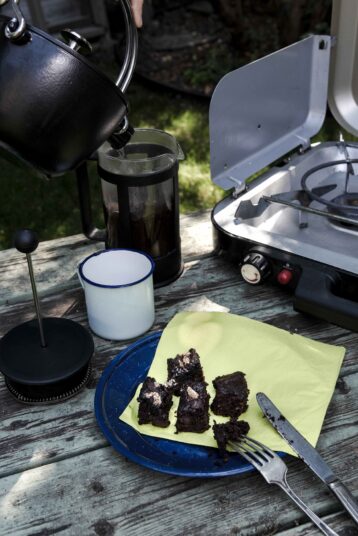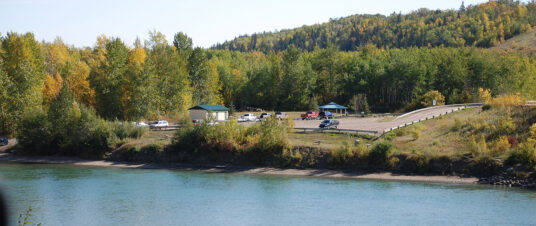Camping Cuisine

Once the tent’s pitched, try these tasty meals designed to make the most of the great outdoors.
With a trusty camp stove, what tasty meals can be created? Camping can be more than hot dogs and marshmallows. Included in the following recipes are both ideas you can prepare at home and cook on site for your next camping trip.
Pancake Mix (top photo)
Prepare this pancake mix ahead and all you need to bring with you is butter, honey butter, maple syrup and berries.
- 2 c. all purpose flour
- 4 tsp. baking powder
- ½ tsp. kosher salt
- ¼ c. ground flaxseed
- ¼ c. buttermilk powder
- ⅓ c. brown sugar
- 1 tsp. vanilla sugar
Combine all these ingredients, stir and pour into a jar or bag. Pop this into your food bin along with a few other ingredients and you are good to go.
On site, in a bowl, add two cups of water to your pancake mix and stir to combine.
Set your camp stove burner to a low/medium flame and add a pat of butter to a pan until it has melted. Using a cookie scoop (any size works, tiny pancakes are fun), drop as many scoops that fit in the pan. Let them cook until tiny bubbles appear on the top of the pancake. Flip the pancakes and cook for another two minutes.
Serve with any topping of choice! Some ideas might include maple syrup and fruit, chocolate spread and bananas, nut butter and honey, honey butter and raspberries.
-
Honey Butter
- 4 tbsp. salted butter, room temperature
- 4 tbsp. honey powder
Mix to combine. This compound butter is fantastic on pancakes and would also work great on toast!
-

Tahini & Chocolate Quick Bread
Bake this quick bread before the camping trip and you have a great hiking snack, a before bed snack or a yum breakfast slice with some hot chocolate or coffee.
- 2 ripe bananas, unpeeled (they can be frozen, just use them defrosted along with their liquid)
- ½ c. packed dark brown sugar
- ¼ c. avocado oil
- ¼ c. tahini
- 1 large egg
- 1 tsp. vanilla extract
- ½ c. all purpose flour
- ¼ c. cocoa
- ½ tsp. kosher salt
- ½ tsp. baking soda
- ½ c. semi-sweet chocolate chips
- 1/3 c. crushed up sesame candy or 1 package (set aside 1 tbsp. for the topping)
Preheat the oven to 325°F. Line a loaf tin with two pieces of parchment paper, leaving an overhang for easy removal of the bread. Set aside. Using either a whisk or a hand mixer, blend together the bananas and the tahini. Add in the oil, egg, sugar and vanilla. Mix to combine.
Add the flour, cocoa, salt, baking soda and whisk or mix to combine. Stir in the chocolate chips and the sesame candy. Pour the batter into the prepared baking sheet, smooth out the top and give the pan a tap on the counter to knock any air bubbles out. Sprinkle the reserved sesame candy over the top.
Bake for 35 to 40 minutes, until a skewer comes out almost clean.
Cool completely in the pan on a cooling rack. Use the parchment sleeves to lift out of the tin. Wrap well for transport and slice on site when ready to eat and enjoy.
-

Camping Calzones
These are great ways to design your own camping meal, requiring quick cooking with many possible flavour combinations.
Flavour combinations:
- mozzarella, tomato, basil
- pesto, shredded cooked chicken, gouda cheese
- tomato sauce, pepperoni, mozzarella
- pear, gouda cheese, pine nuts, basil
- ricotta, nectarine, honey
There is no end to the flavour combinations that can happen with these calzones.
In a large skillet over medium heat on the camp stove, place one tortilla or flatbread in the pan. Add in desired toppings, a pinch of salt and ground black pepper and fold in half. Cook until the bread is golden brown, flip and finish cooking the other side. The cheese should be melted and the calzone golden brown on each side.
Keep cooking until everyone has their calzones!
-
Easy Flatbread
It’s fun and very satisfying to make your own bread products. Having said that, a store-bought flat bread or a thicker tortilla will work wonderfully for camping calzones.
- 1 ½ c. all purpose flour
- 2 tsp. baking powder
- ½ tsp. kosher salt
- 1 ¼ c. plain Greek yogurt (full fat)
- olive oil for frying
- flaky sea salt for finishing
In a large bowl, mix together the flour, baking powder, salt. Whisk to combine. Add the yogurt and use your hands to bring this mixture into a shaggy dough. Knead the dough until it becomes a smooth ball.
On a lightly floured surface, divide the dough ball into four pieces. Roll each of those pieces into a ball. Let the four dough balls rest for 10-15 minutes. Roll the dough into a long pipe and coil the dough like a snail, tucking the end under and then slightly flattening the dough with your hand. Cover with a dish towel and let them rest for another 10 minutes.
Work with one dough ball at a time. Using a rolling pin, roll each dough ball out to roughly an eight-inch circle. Emphasis on “rough!” Do the same with the other three dough balls. While each round is waiting to be cooked, ensure that the counter or work surface is floured so nothing sticks.
Over medium heat, warm up a large skillet. Brush the skillet with olive oil, add one of the rounds to the pan. Cook until bubbles appear and the colour is golden brown. Flip and cook on the other side. These go fast, about two minutes per side. Cook all the rounds, sprinkle with sea salt while still warm and then let cool on a wire rack.
For packing to take camping, in either a large container or a zip top bag, place each flatbread in between sheets of parchment paper and seal the container.
-

Apres Camp Set-Up Soup
The tent is set up, it’s late and getting dark. Time to warm up the soup previously made at home and to enjoy dinner or late night nourishment after travel time and camp set-up.
- 4 tbsp. olive oil
- ¼ onion, finely chopped
- 1 c. carrot, sliced and halved
- 1 ½ tsp. fresh rosemary, finely chopped
- pinch of dried red pepper flakes
- 8 small or 1 large potato, chopped (if it is a thin-skinned potato, no need to peel)
- 1 c. canned mixed beans (freeze the remainder of the can for next time)
- ¾ c. pasta
- ½ tsp. powdered chicken stock or paste (your preference)
- 1 tsp. kosher salt
- ½ tsp. freshly ground black pepper
- 1 bag of tortilla chips to serve
In a medium to large pot, heat the olive oil over medium heat. Add the onion, celery and the rosemary. Cook for eight minutes, stirring occasionally. Add the red pepper flakes, chicken stock, salt and pepper. Cook for one to two minutes, until fragrant. Add the potato and beans along with two cups of water. Bring to a boil, reduce heat and simmer until the potatoes are cooked.
In a separate pot, cook pasta following package directions. Drain and set aside. Pack up the soup and the pasta in separate containers. Add together on site and warm up before serving. Add salt and pepper if required and crunch tortilla chips on top before serving.
-

Sausages and Grilled Vegetables
A simple camp meal including specialty sausages and veggies on the side. Leftovers can be turned into a sliced sausage, grilled veggie sandwich for a hike the next day.
Tip: The veggies can be prepped at home and placed in a resealable container. Keep them in the fridge until transferring into the cooler for the trip.
Grilled Vegetables
- 2 bell peppers, sliced
- 1 small zucchini, sliced
- ½ onion, sliced
- 1 tsp. kosher salt
- 2-3 grinds of black pepper
- 1-2 tbsp. of olive oil
In a cast iron or a camp grill pan, add a tbsp. of olive oil. Over a medium flame, heat the olive oil and then add the veggies. The total cook time is eight to 10 minutes which allows the veggies to attain great grill marks and colour while still maintaining a crisper texture.
-
Grilled Sausages
Sausages, number and flavour based on the crowd
1-2 tbsp. olive oil
In a cast iron pan, over a medium low flame, heat 1 tbsp. of olive oil. Add in the sausages and cook with the lid on. Rotate the sausages so they are golden brown on all surfaces. This should take 10-15 minutes, cut in to one of the sausages to ensure they are cooked all the way through.
Serve with the grilled veggies and a grainy mustard.
[post_title] => Camping Cuisine [post_excerpt] => [post_status] => publish [comment_status] => open [ping_status] => closed [post_password] => [post_name] => camping-cuisine [to_ping] => [pinged] => [post_modified] => 2024-05-21 17:44:26 [post_modified_gmt] => 2024-05-21 23:44:26 [post_content_filtered] => [post_parent] => 0 [guid] => https://www.summercity.ca/?p=19921 [menu_order] => 0 [post_type] => post [post_mime_type] => [comment_count] => 0 [filter] => raw ) [ID] => 0 [filter] => raw [_excerpt] => Once the tent’s pitched, try these tasty meals designed to make the most of the great outdoors. With a trusty camp stove, what tasty meals can be created? Camping can … ) 1











































